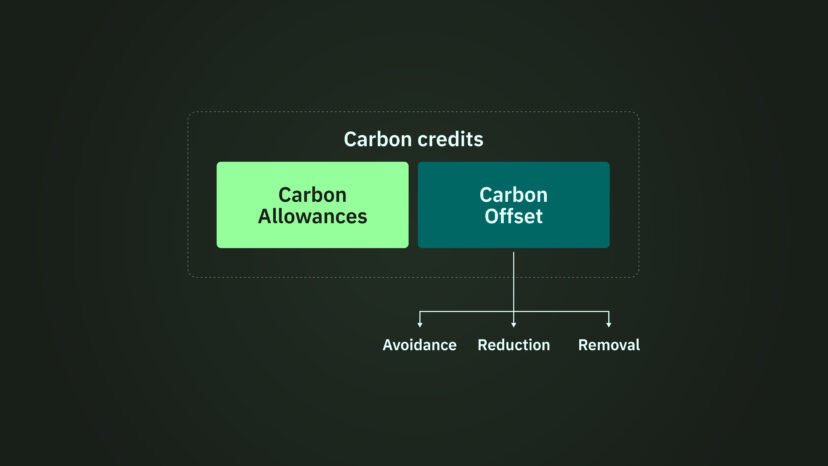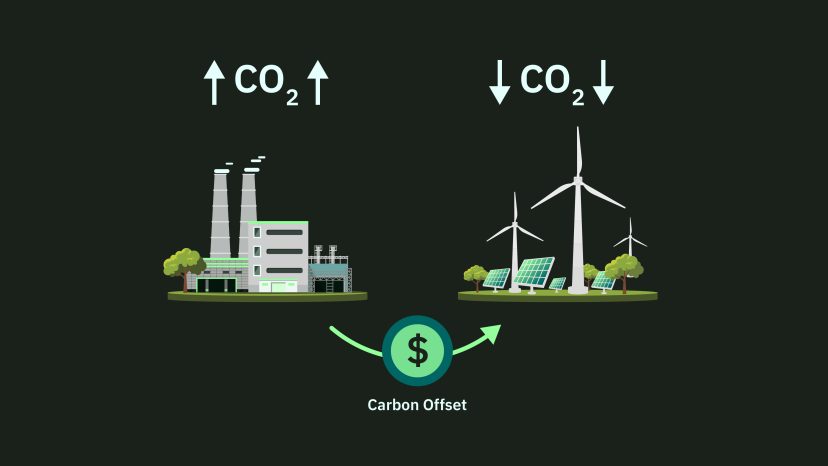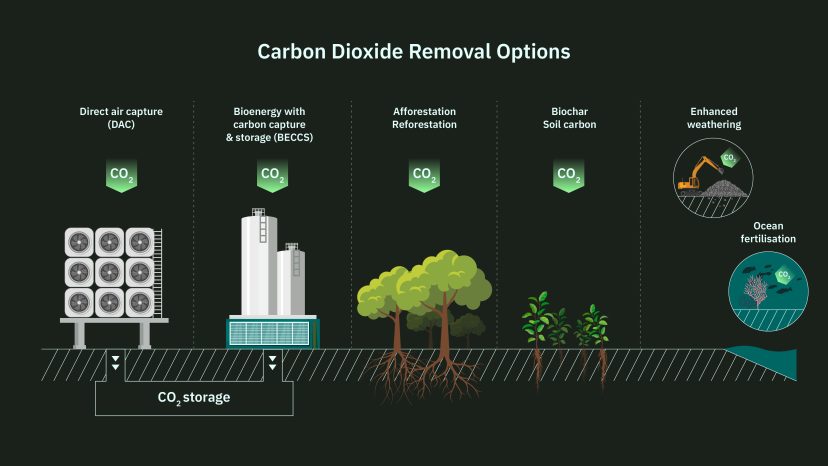What are Carbon Credits, Carbon Allowances, Carbon Offsets, and Carbon Removals?

Introduction
A carbon credit refers to greenhouse gas (GHG) emission reductions from carbon allowances and carbon offsets. Emission reductions are measured using tonnes of carbon dioxide equivalent (1 tCO2e), which reflects the combined impact of multiple greenhouse gases (carbon dioxide, methane, nitrous oxide, flourocarbons), by converting their warming impact to an amount of carbon dioxide with equal warming impact.
The terms ‘allowance’ and ‘offset’ are often used interchangeably, but they describe two distinct elements within carbon markets.
Simple definition of allowances and offsets:
- Carbon Allowance: A right to emit 1 tCO2e within a compliance carbon market
- Carbon Offset: A reduction of 1 tCO2e from the global emission pool
Carbon offsets can be further divide based on how the 1 tCO2e reduction is generated
- Avoidance: Preventing an activity which will generate GHG emissions
- Reduction: Modifying an activity so that it generates fewer GHG emissions
- Removal: Capturing and Storing GHG emissions which have already been released to the atmosphere

What is a carbon allowance?
A carbon allowance is the right to emit greenhouse gases within a compliance market. The European Emission Trading Scheme is an example of a compliance carbon market where there is a cap on the total emissions allowed from certain industries. Participants (emitters and individuals) can buy carbon allowances (allowances act as a carbon tax in this case) if they surpass the cap or sell the remaining allowances under the cap to other participants that need more allowances. Over time, the total amount of emissions allowed is lowered, which raises the price of carbon allowances and incentivizes the adoption of business activities that do not generate carbon emissions.

What is a carbon offset?
A carbon offset is the reduction of GHG emissions from the global GHG emission pool within the Voluntary Carbon Market (VCM). The VCM enables GHG emitters to claim GHG emission reductions from outside of their organization through the purchase of carbon offsets. The VCM serves as a path to compensate for emissions that are not regulated under the compliance market. In 2021, society emitted approximately 33 billion tonnes of CO2e, of which more than 20 billion tonnes of CO2e were not regulated under a compliance market system.
Carbon offsets are used by businesses with emissions that cannot be reduced immediately – in industries like air travel, large-scale energy, and construction – to fulfill environmental objectives while maintaining business activities. Carbon projects sell carbon offsets to support activities they would not have been able to fund otherwise.

What is carbon removal?
Carbon Removal, or Carbon Dioxide Removal (CDR), is the process of collecting CO2 already in earth’s short carbon cycle (plants or the atmosphere) and storing it for the long-term. CDR is a broad category that covers both nature based and engineered approaches. Nature-based CDR includes activities like reforestation and afforestation which use plants to capture and store carbon dioxide. Engineered CDR includes activities like Direct Air Capture and Storage (DACS) and Enhanced Rock Weathering (ERW). Carbon Removal projects may look to generate carbon credits to finance their activities but CDR projects are different from avoidance and reduction projects because there is typically a higher certainty that the carbon benefits are real and can be attributed to the carbon offsets – warranting higher prices.
How are carbon offsets made?
Carbon projects generate carbon offsets by performing activities that fall under one of the three categories below. Project activities commonly include the protection, monitoring, and rehabilitation of ecosystems as well as social activities in communities connected to the project including training, education, and employment in ecosystem conservation.
Reduced emissions
Projects that reduce the GHG emission intensity of current operating processes. For example, the implementation of renewables into power consumption such as biodiesel, wind, and solar.
Avoided emissions
Projects that avoid future GHG emissions. For example, projects that conserve existing forests avoid the emissions created by removing and destroying trees. REDD+ projects specifically look to avoid emissions from the various types of degradation that occur within forests.
Removed emissions
Projects that capture and store greenhouse gases from the atmosphere. There are many types of carbon removal projects; some examples include planting new forests, increasing carbon capture in soil, and direct air capture – which extracts carbon dioxide directly from air.
Do carbon offsets make real progress towards environmental goals?
The Voluntary Carbon Market contains offsets from a wide range of projects that claim emission reductions, but many offsets available lack credibility, meaning they lack the evidence needed to ensure real carbon and other benefits. In order to be considered credible, it is important that offsets come from projects that address the certain key principles. While the names differ between organizations, the core concepts remain consistent and are summarized below.
Additional (Real)
The project must demonstrate; the necessity for carbon finance to enable the project, it is not required by laws/policies/regulations, is not common practice, and the baseline scenario is credible.
Verifiable (Measurable)
Verifiability concerns how a project measures, reports, and verifies the actual amount of carbon that has been removed by a project. This includes how a project considers; sources of emissions that occur to enable the removals, what would occur if there was no project (e.g. a Baseline or Business as Usual), and how the project may displace emissions (economic leakage).
Accurate Accounting
Accurate accounting goes beyond calculations to cover monitoring, reporting, and verification methods as well as sound consideration of the potential for leakage. The project must use transparent accounting that reflects the best science available, identify and account for uncertainties, use conservativeness in estimation, account for all inputs and outputs for emissions, account for QAQC in monitoring plan, validate calculations using a third party, and ensure all offsets are unique. Leakage occurs when attempts to reduce GHG emissions in one place result in a shift of emissions to another location. For example, leakage can happen if a project protects a forest from illegal logging activities but does not ensure illegal logging isn’t happening nearby on non-protected forest land.
Durability (Permanence)
Durability addresses how long the carbon is expected to be stored and what happens if stored carbon is released back into the atmosphere.
Safety and Legality
Projects must adhere to all relevant safety, environmental, and social regulations including the identification and mitigation of potential risks. This should include stakeholder engagement to identify and mitigate risks of the project’s development and operation.
Sustainable Co-Benefits (Net Positive Impacts)
Co-benefits of a project describes the non-carbon benefits that a project provides to communities and the environment that it impacts. The project should quantify the potential positive and negative impacts to people, air, water, and land quality that occur as a result of the project and identify the safeguards in place to mitigate the risks. It is also important for projects to engage with stakeholders over the life of the project to continually improve social and environmental outcomes.
Who issues carbon offsets?
Credible carbon offsets are issued by a standard body like Verra, Gold Standard, or American Carbon Registry, which ensures that the quantification of a carbon project’s emission reductions follows a standard, public methodology and is verified by a third party. Standard bodies list projects and their details on a public register to avoid double counting and track the sale and use of issued offsets.
Summary of carbon offsets
‘Carbon credits’ refers to both carbon allowances and carbon offsets, which both refer to a reduction in GHG emissions. The purpose of carbon credits is to attribute a value to emission reductions, avoidances, and removals. Credible carbon allowances exist within compliance carbon markets, while carbon offsets exist within voluntary carbon markets. Carbon allowances regulate emissions from certain industries and are managed by a regulatory body. Credible offsets follow a rigorous and publicly-available set of rules – a methodology – and are issued by a recognized standard body.